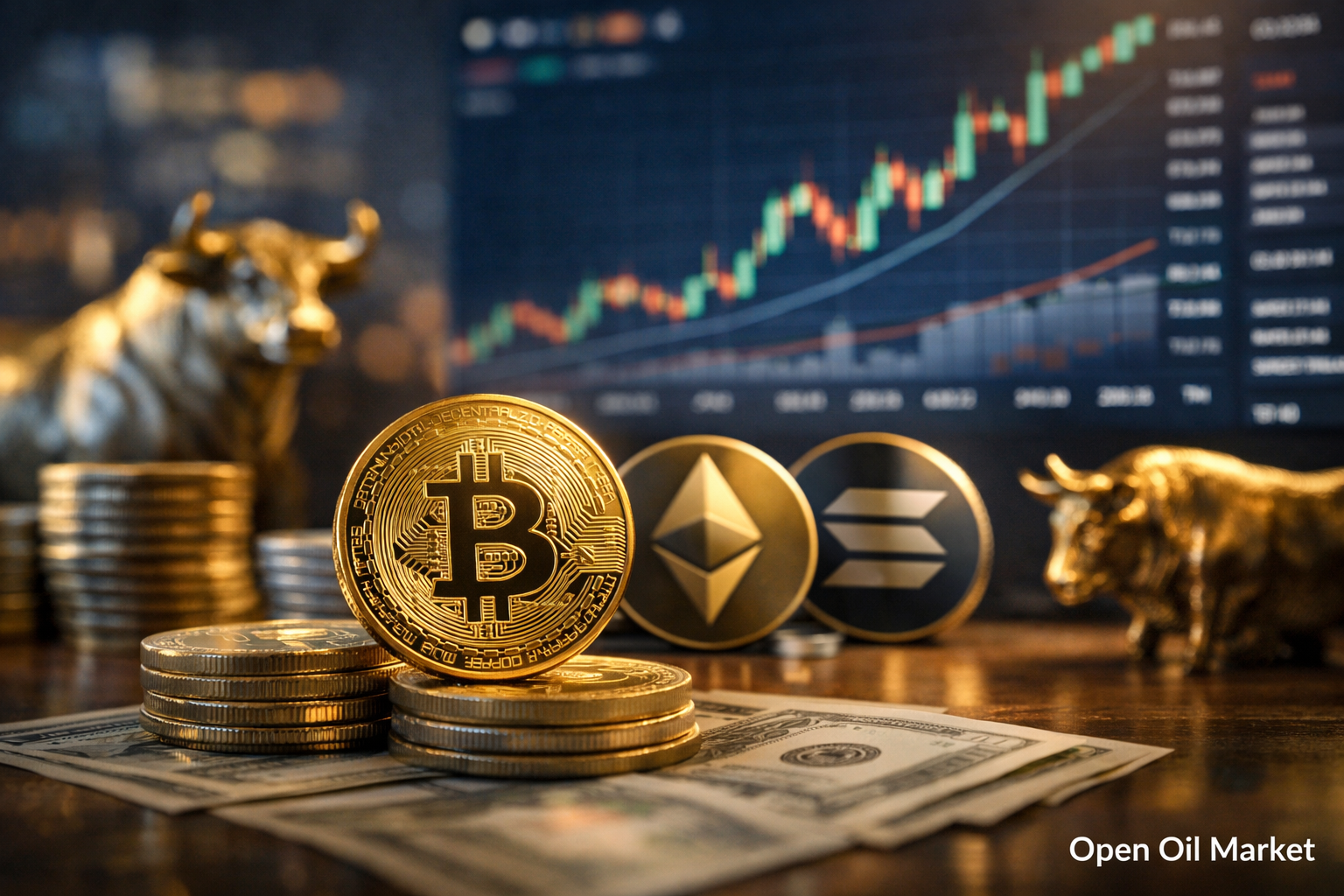
Latest Cryptocurrency News as of October 18, 2025: Bitcoin Below $110K, Altcoin Volatility, Anticipation of XRP ETF Decision, Analysis of Ethereum and Other Top Cryptocurrencies, Market Forecasts.
As of the morning of October 18, 2025, the cryptocurrency market is attempting to stabilize following a significant correction that occurred last week. Earlier in October, Bitcoin reached an all-time high (exceeding $126,000), but then experienced a rapid decline due to external factors. Currently, the first cryptocurrency is trading around $105,000, over 15% lower than its recent peak, yet still significantly above the levels observed at the beginning of the year. Many leading altcoins have also retraced from their maximum values, with market capitalization decreasing to approximately $3.7 trillion. Investors remain cautious amid increased volatility and are awaiting new drivers, including regulatory decisions regarding cryptocurrency exchange-traded funds (ETFs).
Bitcoin Holds Above $100K
After hitting a new record of around $126K earlier in the month, Bitcoin (BTC) faced a substantial correction. On the night of October 10-11, negative macroeconomic news (including a statement by the U.S. administration about imposing 100% tariffs on goods from China) triggered a wave of sell-offs: BTC price plummeted from around $122,000 to approximately $112,000 within hours, with some exchanges (such as Binance) briefly dipping to ~$102,000. Since then, the market has somewhat stabilized, and Bitcoin is now trading around $105-110K, maintaining above the psychologically significant $100,000 level. The market capitalization of BTC stands at about $2.1 trillion, accounting for about 58-60% of the total cryptocurrency market capitalization. A key benchmark for bulls is the $100,000 mark: its confident retention may signal the establishment of a local market bottom.
Experts note that Bitcoin's current weakness is largely due to profit-taking after a prolonged rally. Fundamental factors remain relatively favorable: recent months have seen an influx of institutional investors into BTC, strengthening Bitcoin's position as a safe-haven asset. However, macroeconomic risks continue to impact short-term dynamics. The sharp surge in gold prices to a record market capitalization of ~$30 trillion diverts some capital to traditional "safe-haven" assets, temporarily diluting the narrative of Bitcoin as "digital gold." As a result, Bitcoin is facing downward pressure, demonstrating its most "oversold" level relative to gold in the last three years. Investors will closely monitor whether BTC can maintain its current positions or if a new wave of decline will occur, potentially dropping below $100,000.
Ethereum Retreats from Its Highs
In the wake of Bitcoin's decline, Ethereum (ETH) — the second-largest digital asset by capitalization — has also come under pressure. Earlier in the month, Ether was on a rapid upward trajectory, closely approaching its all-time high ($4,890 reached in November 2021); at its peak, the price climbed to around $4,800. However, the market correction did not spare Ethereum. During the recent downturn, the price of ETH fell more than 12% in a single day, dropping to approximately $3,400. Currently, Ethereum is fluctuating around $3,700–$3,800, having dipped below the key $4,000 mark. Despite the pullback, Ether remains the largest altcoin with a market capitalization of about $450 billion (approximately 12% of the market volume) and continues to play a central role in the smart contract ecosystem.
Previously, institutional interest in Ethereum was on the rise: the first spot ETFs for Ether were launched in the U.S., simplifying access for large investors to this asset. Significant capital inflows were observed in ETH-related funds in the first weeks of October. However, the subsequent decline in sentiment led to a withdrawal of funds from ETH as well. Nevertheless, many analysts highlight the resilience of Ethereum's fundamental metrics — the network continues to process high transaction volumes, the decentralized finance (DeFi) sector is growing, and the recent transition to a "Proof-of-Stake" model has made ETH a deflationary asset in the long term. These factors suggest that following the current correction, Ether can reclaim lost positions, especially if market conditions improve.
Altcoins Under Pressure
The broader altcoin market is experiencing heightened volatility. Following a general upswing in September and early October, the prices of most major altcoins have significantly declined. Over the past weeks, many of the top 10 cryptocurrencies have dropped by 15-30% from recent highs. However, the dynamics vary depending on specific projects. Several altcoins managed to approach their record levels before the correction. For instance, Solana (SOL) rose to ~$200 last week for the first time in years amid optimism surrounding potential approval of the first spot ETF for Solana in the U.S. Binance Coin (BNB) even reached new heights: the Binance exchange token surpassed $1,000 despite ongoing regulatory pressure on the platform itself. These instances reflect that investors maintained a risk appetite up until the recent downturn.
On the other hand, some projects experienced particularly severe price drops. For example, Toncoin (TON), which was previously in the top 15 by capitalization, plummeted nearly 80% from its peak values, highlighting the risks of overheated segments of the market. Major altcoins also felt the pressure: the prices of Cardano (ADA) and Dogecoin (DOGE) fell sharply during the worst days (by as much as -20% and -23% in a single day, respectively). Nonetheless, after the initial shock, some altcoins managed to recover a small portion of their losses. Currently, the total market capitalization of the altcoin sector (excluding Bitcoin) is estimated at around $1.6–1.7 trillion. Investors are selectively returning to certain high-quality projects; however, overall sentiment remains cautious. Until macroeconomic conditions clarify and positive news emerges, many altcoins are likely to remain in a sideways movement with heightened volatility.
XRP Awaits ETF Decision
The XRP token from Ripple has become a focus of investor attention. After Ripple's legal victory over the SEC in the U.S. in July (the court confirmed that XRP sales on the secondary market do not constitute a violation of securities laws), the coin experienced a rally: by the beginning of autumn, XRP was trading around a multi-year high of ~$3.0, temporarily placing it among the market leaders. However, the recent downturn also affected XRP — the price is currently around $2.30, roughly 20% lower than its peak values. The market capitalization of the token is estimated at ~$130 billion, and XRP remains among the top five cryptocurrencies.
A key upcoming event for XRP is the decision on the spot ETF. The investment community is anxiously awaiting October 18 — the deadline by which the U.S. Securities and Exchange Commission (SEC) is expected to render a decision on Grayscale's application to launch the first ETF tied to XRP. Approval of such an ETF would be a landmark event, potentially opening access to XRP for a wide range of institutional investors and bolstering trust in the asset. The market is experiencing cautious optimism: analysts assess the likelihood of a positive decision as relatively high, considering precedents set by Bitcoin and Ethereum. In anticipation of the news, trading volume for XRP has increased, although volatility has also risen, with traders pricing in the outcome of the decision. Additional positive news for Ripple's ecosystem includes the company's acquisition of the startup GTreasury for $1 billion. This expansion into corporate treasury software signals Ripple's long-term ambitions and indirectly supports XRP's value. However, if the ETF decision is postponed or denied, the XRP market may face short-term pressure, prompting market participants to closely monitor the SEC's actions.
Institutional Investments: Outflows After the Rally
One of the key trends recently has been a reversal in institutional flows. If in the summer and early autumn large investors were increasing their allocations to cryptocurrencies, after the market reached new highs, profit-taking began. According to analytical services, as of October 16, all Bitcoin ETFs collectively recorded a capital outflow of around $536 million in a single day — the first synchronous outflow of this magnitude since their inception. This indicates that some institutional players decided to reduce their risk positions following the sharp price increases. Such capital outflow intensified downward pressure on the market this week.
Concurrently, an interesting market shift is observed: investors are redirecting their focus to traditional "safe haven" assets. The historic rise in gold prices (the market capitalization of gold surpassed $30 trillion) coincided with the correction in the cryptocurrency market, highlighting the shift in sentiment towards more conservative instruments. At the same time, regulatory positions are becoming stricter. U.S. Federal Reserve representatives, for instance, have warned about potential risks to financial stability due to the rapid growth of stablecoins. The Financial Stability Board (FSB) of the G20 points to a "substantial gap" in global cryptocurrency regulation, calling for coordinated measures. These factors are temporarily cooling large players' appetites for digital assets.
However, long-term involvement of institutional players in the crypto industry continues to strengthen. In 2025, the first spot Bitcoin and Ethereum ETFs were launched in the U.S., and applications for the launch of funds associated with other cryptocurrencies (including Solana and Cardano) are currently under review by regulators. This suggests that strategic investors are not abandoning the market but merely adjusting their positions. Many hedge funds, asset management firms, and even pension funds still maintain significant holdings of cryptocurrencies in their portfolios. In the near term, much will depend on the macroeconomic situation: if geopolitical tensions decrease and financial markets stabilize, a return of institutional capital to cryptocurrencies could be anticipated.
Market Sentiment and Volatility
The rapid drop in prices has been accompanied by a surge in short-term volatility in the cryptocurrency market. The Fear and Greed Index for cryptocurrencies has plummeted to a level of 24 out of 100 ("extreme fear"), its lowest reading in the past year. This reflects a sharp change in sentiment: just a couple of weeks ago, the indicator was in the greed zone, signaling euphoria, but now investors are frightened by the scale of the correction. Historically, such extreme index values have often coincided with local trend reversal points; however, it does not guarantee this — if negative factors persist, fear could turn into panic.
Statistics from the derivatives market confirm the scale of the recent upheavals. In recent days, the total volume of liquidated positions on cryptocurrency exchanges has exceeded $1.2 billion. Almost 80% of this amount was attributed to long positions, meaning "bullish" trades that were incorrectly calculated. The sharp price decline has liquidated over 300,000 margin accounts of traders worldwide. The largest single liquidation was a long position on ETH worth ~$20 million closed on the decentralized exchange Hyperliquid. Such episodes underscore the risks of using high leverage: when the market moves against leveraged positions, a chain reaction of margin calls occurs, exacerbating price downturns.
Analysts advise market participants to remain vigilant. On one hand, current levels for many assets appear attractive for long-term investors following the correction; on the other hand, further short-term declines cannot be ruled out. Technical indicators suggest that the market is oversold: for example, the price ratio of Bitcoin to gold has dropped to its lowest point in the last three years, indicating potential for a rebound. At the same time, uncertainty surrounding regulation and macroeconomics remains high. In this environment, experts recommend adhering strictly to risk management principles, avoiding excessive use of borrowed funds, and closely monitoring the news flow that could instantly affect prices.
Forecasts and Expectations
Despite the current correction, many analysts maintain an optimistic view of the cryptocurrency market in the medium term. They believe that the recent decline is largely health-promoting and does not negate the bullish trend established in 2024-2025. Major British bank Standard Chartered, for instance, recently reaffirmed its ambitious forecast: bank analysts expect Bitcoin prices to rise to ~$200,000 by the end of 2025, and Ethereum to ~$7,500. Should these predictions materialize, the current downturn could be viewed merely as a temporary phase before further upward momentum. Some experts suggest that the crypto market may be entering a "second phase" of the growth cycle: following peak updates and intermittent corrections, a new stage of price increases may follow contingent on improved external conditions.
At the same time, several specialists urge caution, pointing to persisting risks. Concerns arise regarding the potential tightening of monetary policy, geopolitical factors (including trade wars and regional conflicts), and unpredictable regulatory actions. There is a viewpoint that the peaks reached in October (~$125-126K for BTC) could represent the highest point of the current cycle, with the market potentially facing prolonged consolidation or even a deeper decline ahead. Some analysts do not rule out that Bitcoin may closely approach $150,000 only in the latter half of 2026, following another halving event and assuming a favorable macroeconomic environment. Such forecasts emphasize the need for patience among long-term investors.
Overall, consensus among most market participants is that the fundamental drivers of cryptocurrency growth remain intact. Technological advancements (introduction of new protocols, increased scalability, and blockchain adoption across various industries) and institutional acceptance (ETF launches and participation of major companies) will continue to support the sector. In the absence of new shocks, the total cryptocurrency market capitalization may resume growth in the latter half of the year. Investors are advised to combine optimism with prudence: when forming positions for the future, maintaining a diversified portfolio and a contingency plan for adverse scenarios is crucial.
Top 10 Most Popular Cryptocurrencies
As of the morning of October 18, 2025, the top ten most popular cryptocurrencies by market capitalization are as follows:
- Bitcoin (BTC) — the first and largest cryptocurrency. BTC is trading around $105,000 after a recent correction; market capitalization exceeds $2 trillion (≈59% of the total market).
- Ethereum (ETH) — the leading altcoin and smart contract platform. Current ETH price is ~$3,770, which is below recent peaks, with a capitalization of around $450 billion (≈12% of the market).
- Tether (USDT) — the largest stablecoin, pegged to the U.S. dollar at 1:1. USDT is widely used for trading and payments, with a capitalization of approximately $160 billion; the coin consistently holds around $1.00.
- Binance Coin (BNB) — the coin of the largest cryptocurrency exchange Binance and the native token of the BNB Chain. BNB's price exceeds $1,000 (close to its historical peak), with a capitalization of around $160 billion. Despite regulatory risks surrounding Binance, the token remains in the top 5 due to its wide range of applications on the exchange and in DeFi.
- Ripple (XRP) — the token of the Ripple payment network for cross-border settlements. XRP is trading around $2.30; market capitalization is about $130 billion. Thanks to legal clarity on XRP's status in the U.S. in 2025, the coin maintains its standing among market leaders.
- Solana (SOL) — a high-performance blockchain platform for decentralized applications. SOL is priced at around $180 per coin (capitalization ~$90 billion), having recovered to 2022 levels. Interest in Solana is supported by expectations of ETF launches and growth in its project ecosystem.
- USD Coin (USDC) — the second-largest stablecoin, backed by reserves in dollars (issuer — Circle). The price of USDC is maintained at $1.00, with a capitalization of around $64 billion. USDC is widely used by institutional investors and in DeFi due to its transparent reserves and regulation.
- TRON (TRX) — a platform for smart contracts and decentralized applications, particularly popular in Asia. TRX is trading around $0.31; market capitalization is ~ $28 billion. TRON maintains its place in the top 10 partly due to its network's use for issuing stablecoins (a significant portion of USDT circulates on the Tron blockchain).
- Dogecoin (DOGE) — the most recognized meme cryptocurrency, originally created as a joke. DOGE hovers around $0.18 (capitalization ~$26 billion), supported by a dedicated community and periodic attention from celebrities. While Dogecoin's volatility remains high, this coin continues to rank among the top ten, demonstrating remarkable resilience in investor interest.
- Cardano (ADA) — a blockchain platform focusing on a scientific approach to development. ADA is priced at about $0.62 (capitalization ~$20 billion) after a recent price drop. Earlier this year, Cardano attracted attention with plans to launch its ETF and an active community believing in the project's long-term growth, allowing the coin to remain among the most significant crypto assets.
Cryptocurrency Market as of October 18, 2025
Prices of major cryptocurrencies:
- Bitcoin (BTC): $105,200
- Ethereum (ETH): $3,758
- XRP (XRP): $2.27
- BNB (BNB): $1,060
- Solana (SOL): $180
- Tether (USDT): $100.00
Market Indicators:
- Total cryptocurrency market capitalization: ~$3.70 trillion
- Bitcoin's share: 59.2%
- Fear and Greed Index: 24 (extreme fear)
Daily Leaders:
- Gainers: Bitcoin Cash (BCH) — +10%
- Decliners: Conflux (CFX) — -9%
Analysis: Bitcoin and Ethereum are attempting to consolidate near their current support levels; however, market sentiment remains cautious (fear sentiment index). The growth leader BCH is showing a local inflow of interest amid low prices, while the decline in CFX is likely related to profit-taking or negative news regarding the project. Overall, the main crypto assets are holding their positions after the correction, but market participants are closely monitoring the situation. Upcoming regulatory decisions and macroeconomic signals could determine further price movement, so investors are acting with consideration of risks and volatility.




